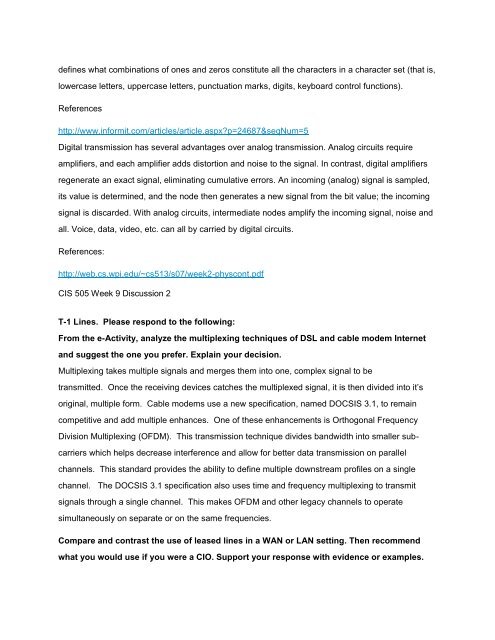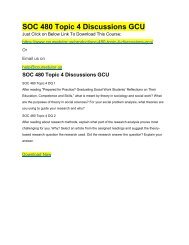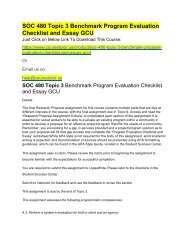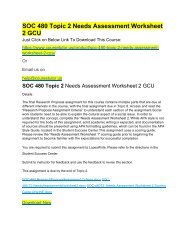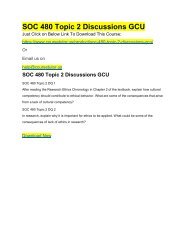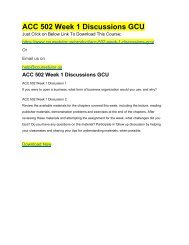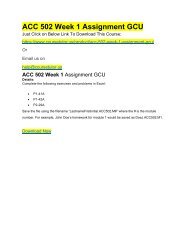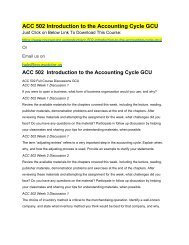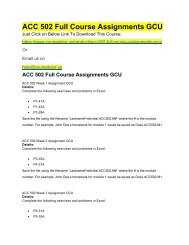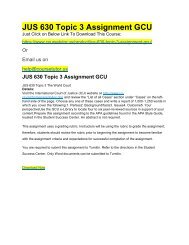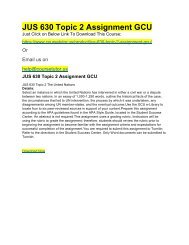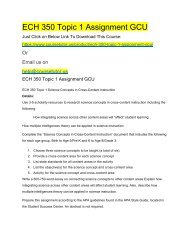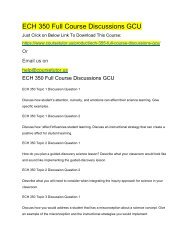CIS 505 Week 9 Discussions STR
You also want an ePaper? Increase the reach of your titles
YUMPU automatically turns print PDFs into web optimized ePapers that Google loves.
defines what combinations of ones and zeros constitute all the characters in a character set (that is,<br />
lowercase letters, uppercase letters, punctuation marks, digits, keyboard control functions).<br />
References<br />
http://www.informit.com/articles/article.aspx?p=24687&seqNum=5<br />
Digital transmission has several advantages over analog transmission. Analog circuits require<br />
amplifiers, and each amplifier adds distortion and noise to the signal. In contrast, digital amplifiers<br />
regenerate an exact signal, eliminating cumulative errors. An incoming (analog) signal is sampled,<br />
its value is determined, and the node then generates a new signal from the bit value; the incoming<br />
signal is discarded. With analog circuits, intermediate nodes amplify the incoming signal, noise and<br />
all. Voice, data, video, etc. can all by carried by digital circuits.<br />
References:<br />
http://web.cs.wpi.edu/~cs513/s07/week2-physcont.pdf<br />
<strong>CIS</strong> <strong>505</strong> <strong>Week</strong> 9 Discussion 2<br />
T-1 Lines. Please respond to the following:<br />
From the e-Activity, analyze the multiplexing techniques of DSL and cable modem Internet<br />
and suggest the one you prefer. Explain your decision.<br />
Multiplexing takes multiple signals and merges them into one, complex signal to be<br />
transmitted. Once the receiving devices catches the multiplexed signal, it is then divided into it’s<br />
original, multiple form. Cable modems use a new specification, named DOCSIS 3.1, to remain<br />
competitive and add multiple enhances. One of these enhancements is Orthogonal Frequency<br />
Division Multiplexing (OFDM). This transmission technique divides bandwidth into smaller subcarriers<br />
which helps decrease interference and allow for better data transmission on parallel<br />
channels. This standard provides the ability to define multiple downstream profiles on a single<br />
channel. The DOCSIS 3.1 specification also uses time and frequency multiplexing to transmit<br />
signals through a single channel. This makes OFDM and other legacy channels to operate<br />
simultaneously on separate or on the same frequencies.<br />
Compare and contrast the use of leased lines in a WAN or LAN setting. Then recommend<br />
what you would use if you were a CIO. Support your response with evidence or examples.


